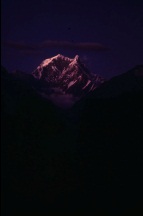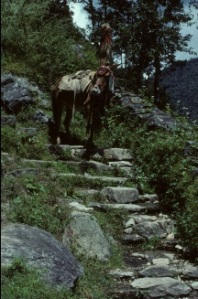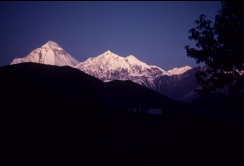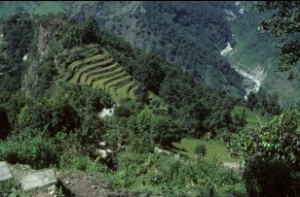The Mountains of Nepal: Scientific investigations
This lesson will facilitate the collaborative effort to research and anayze the mountain ecosystems of Nepal. Activities include a brainstorming activity, where students think about ecosystems and biodiversity; a research activity, where students use a variety of resources to gather information about the mountain ecosystems of Nepal; There is also a journal activity, where students create journal entries based on the information gathered in their research.
A lesson plan for grades 6-12 Information Skills, Science, and Social Studies
Mountains are a dominant feature of Nepal’s physical landscape. Nepal’s elevation ranges from about 197 feet above the sea level to the highest point on earth — Mount Everest, at 29,028 feet. In terms of biodiversity, Nepal is one of the richest countries in the world due to the unique variety of species found there. In this lesson, students will learn about the mountain ecosystem of Nepal and begin to understand the terrain, climate, and biodiversity of the mountain regions.
Learning outcomes
Students will:
- define ecosystem and biodiversity
- apply scientific tools, personal research observation, and research logs
- gather information about the ecosystems found in the Nepalese mountains
- locate Nepal and specific mountains or mountain ranges on a map
- view photographs and research on the web, in reference materials, and from other sources and take notes on Nepalese mountain ecosystems
- create a five-entry journal of a short mountain “ecosystem” hike using research logs, images, and maps gathered
BRAINSTORM — one per student
GlobalEcosystems Research Log — one per pair of students
Ecosystem Hike Journal — five per student
- Images of Nepal:
Sunset view of Nilgiri mountain peaks, Nepal
Donkey on a mountain trail in Nepal
Dhaulagiri mountain, Nepal
Nepal mountain landscape
Familiarize yourself with Nepal, the Nepalese mountains, ecosystems, and biodiversity. Information can be found at the following sites:
Nepal:
- CIA World Factbook overview of Nepal
- Nepal Country Profile from the BBC.
mountains of Nepal:
- Geography of Nepal article from Wikipedia
- “Mountain Ecosystem” article from Encyclopedia Britannica
ecosystems:
- Resources for Science Learning website from the Franklin Institute
- See definition in “Critical vocabulary”
biodiversity:
- Biodiversity and Conservation website from the Field Museum
- See definition in “Critical vocabulary”
Activities
Activity one: Ecosystems and biodiversity
- Distribute brainstorm handout.
- Key Questions:
- Do you know what the word ecosystem means.
- Can you think of the word ecosystem; What words do you think of?
- List as many words as they can.
- Write your ideas down on your graphic organizers as you think.
- Read the introduction to mountain ecosystems and biodiversity:
An ecosystem is an environment of living organisms interacting with each other. Ecosystems occur in all sizes. A pond, a river, and a forest are all examples of ecosystems. A community of living things (plants, animals, insects, fungi, and bacteria) along with non-living things (sunlight, soil, water, rocks) makes up an ecosystem.
Even a small area of land can offer wide biodiversity in plant life; that is, an ecosystem is composed of many different organisms. Biodiversity or biological diversity is the variation of life forms within a given ecosystem or biome — or for the entire Earth.
Mountains are one of the world’s greatest sources of biodiversity. That means that in mountains there are many different kinds of plants and animals that live in the wild or are grown by farmers. Because of the rapid changes in altitude and temperature along a mountain slope, multiple ecological zones exist, sometimes ranging from dense tropical jungles to glacial ice within a few kilometers.
The extraordinary number of ecological niches possible in mountains is typified by the Makalu region of east Nepal, which is estimated to harbor more than 3,000 plant species. This includes 25 species of rhododendron, 50 species of primroses, 45 species of orchids, 80 species of fodder trees and shrubs, and 60 species of medicinal plants.
- Participate in discussion about local and mountain biodiversity by answering questions:
- What is biodiversity?
- Why are mountains home to so many different living things?
- Does the area around your community have many different ecosystems where different kinds of plants and animals live, or does it have just a few?
- What factors or activities threaten mountain biodiversity?
Activity two: What is a mountain?
- Read the following background information about mountains:
Mountains are the most conspicuous landforms on earth. They are found on every continent from the equator to the polar regions. Mountains are three-dimensional in nature (i.e., they extend north-south, east-west, and vertically), and contain the most extensive and varied climatic conditions, vegetation, wildlife, and human cultural diversity of any landform on earth. Nepal is filled with mountains and mountain ranges.
- Locate Nepal and New Mexico on a large map of the world, with the National Geographic Map Machine or using the USGS Ecosystem Mapper. Then see the more detailed map of Nepal. Point out Nepal’s size relative to its surrounding countries, it is sometimes described as “a yam between two rocks” because of its location between India and China.
- Tell students that Nepal is a landlocked country 563 miles east to west, and 160 miles north to south. Find your own town, city, or state on the National Geographic Map Machine or Google maps, and compare its size to the size of Nepal. Switch between map views (road map, satellite, etc.) for both locations.
- Have students study the maps, readings, and other reference materials for this lesson to answer the following questions:
- What are the borders of Nepal?
- What is the terrain and elevation?
- What are the variations of climate in Nepal?
- How many mountain ranges are in Nepal and where are they located?
Nepal mountain ecosystem and biodiversity
- Refer back to your previous brainstorming on ecosystems and biodiversity. Now do partner research on the particular ecosystems found in the Nepalese mountains and the biodiversity there.
- Get into pairs and give each team a copy of the research log. Go over the instructions on the research logs and share any needed computer use information. Have students use the library catalog, databases, and internet resources to find the requested information. Instruct students to take notes, which will be used later in the lesson as a basis for an ecosystem hike journal in activity three. Tell students to select a mountain range in Nepal and gather descriptions, facts and images, and references of:
- Mountain range or mountain name and location
- Climate
- Plants
- Animals
- Insects
- Terrain
- Maps
Conduct your research on any site you find appropriate. For suggestions, see “Resources for student research” below.
Activity three: Nepal ecosystem hike
- In this activity, students will use their imaginations to describe the natural world as they investigate the Nepal mountain ecosystem. Begin with a discussion of students’ prior experiences with mountains. Ask students if they have ever been to the mountains. Did they hike? When did they go? What was the weather like? What plants and animals did they encounter?
- Have students view the images of Nepal listed above under “Materials needed,” and instruct them to read the captions. You may view the images online, or print copies of the images.
- Plan a Nepal mountain hike using the images of Nepal and their brainstorming sheets and research logs from the previous activities. Students will create a five-entry journal of a short mountain ecosystem hike using the gathered materials.
- Write your answers on scrap paper, drawing on what you have learned about Nepal. Write your answers about your imagined Nepal hike.
- Site name/location
- Date
- Time of day
- Temperature
- Weather conditions (For example: is it cloudy, sunny, windy, raining?)
- Wind conditions
- Soil conditions (For example, is it moist or dry?)
- Imagine that you are standing on a mountain trail in Nepal. Close your eyes and imagine what you can see around you. Visualize a pathway that you will travel over five days. For each day of your hike, take note of the following:
- What do you see from where you are?
- What sounds do you hear?
- If you were to eat a meal of wild plants or animals there, what kind of food would it be?
- What distinctive smells might you notice in this place?
- Are there are fruits or flowers on individual trees or plants?
- Are there interactions among insects or animals, like mating or fighting, or between insects and plants, like feeding and pollinating?
- Get out the journal page templates (five), and use your answers to the questions above to develop their five journal entries. While this is a creative exercise, all of your entries should be grounded in facts about Nepal and its mountain ecosystems. Emphasize the importance of using concrete detail taken from research, and record references from their research logs on the journal page in the space provided. For each of the five days, write a draft of a six-to-eight-sentence paragraph describing your hike destinations, with the goal of making your hike sound very appealing to a reader. Be creative in any of the following ways: record data; scribble questions; make sketches, drawings, diagrams, graphs, or flowcharts; and use the images gathered in research. Transfer all the notes, drafts, and images to the journal page template.
Assessments
- Write a two-paragraph essay about preserving biodiversity in the mountains. You can answer the following questions as guidelines for writing the paragraphs:
Paragraph 1: Why do you think biodiversity in the mountains of Nepal should be preserved? Give two reasons.
Paragraph 2: Of the reasons you listed for preserving biodiversity, which do you think would be the most likely to convince people that biodiversity should be preserved? Why?
- Research organizations that are dedicated to preserving biodiversity. Many of these organizations have websites. Find an organization, give its web address, a brief overview of what the organization, its activities and history.
Record information about local ecosystems. Ask students to copy the example of the recording chart below. Find an area around your neighborhood to observe as an ecosystem.
Instructions:
- Record the name of each different type of living thing you see in the first column. For example, if they see red ants, you should record “red ants” in the first column.
- Record the quantity of this life form in the second column. For example, if they saw ten red ants, they should record the number ten.
- Describe what they saw, what it looked like, sounded like, smelled like, and felt like in the third column.
|
Type of living thing |
Quantity |
Observations |
Tell about your findings:
- Why is biodiversity important?
- Why are mountains important for biodiversity?
- Ask your students to estimate the number of different kinds of living things they observed.
You can bind your journals into books using Susan Kapuscinski Gaylord’s Making Books with Children website.
Websites
- Nepal:
CIA World Factbook overview of Nepal
Nepal Country Profile from the BBC.
National Geographic Map Machine
- Mountains of Nepal:
Geography of Nepal article from Wikipedia
“Mountain Ecosystem” article from Encyclopedia Britannica
- Ecosystems:
Resources for Science Learning website from the Franklin Institute
- Biodiversity:
Biodiversity and Conservation website from the Field Museum
- Other websites:
Resources for student research
- General:
Internet Public Library Kidspace
American Library Association’s Great Web Sites for Kids
- Specific:
Natural History Notebooks: Asia
“Mountain Ecosystem,” from the Britannica Online Encyclopedia
“Plants, Animals, and Birds of Nepal” from Nepal Vista
Critical vocabulary
biodiversity
According the U.S. Agency for International Development, biodiversity is the variety and variability of life. Biodiversity can be conceived as a system consisting of many elements or aspects: genes, species, ecosystems, and ecological processes that both support and result from this diversity. All of these elements of living systems interact with each other to produce the web of life on earth, a whole much greater than the sum of its parts.
ecosystem
A community of organisms and the physical environment in which they interact
Himalayas
Mountain range extending 1500 miles on the border between India and Tibet; this range contains the world’s highest mountain, Mt. Everest.
mountain
An elevated landform of high local relief (the difference in elevation between the lowest and highest points in an area), with the majority of its surface in steep slopes, and displaying distinct variations in climate and vegetation zones from its base to its summit.
trekking
A form of walking, undertaken with the specific purpose of exploring and enjoying the scenery.



